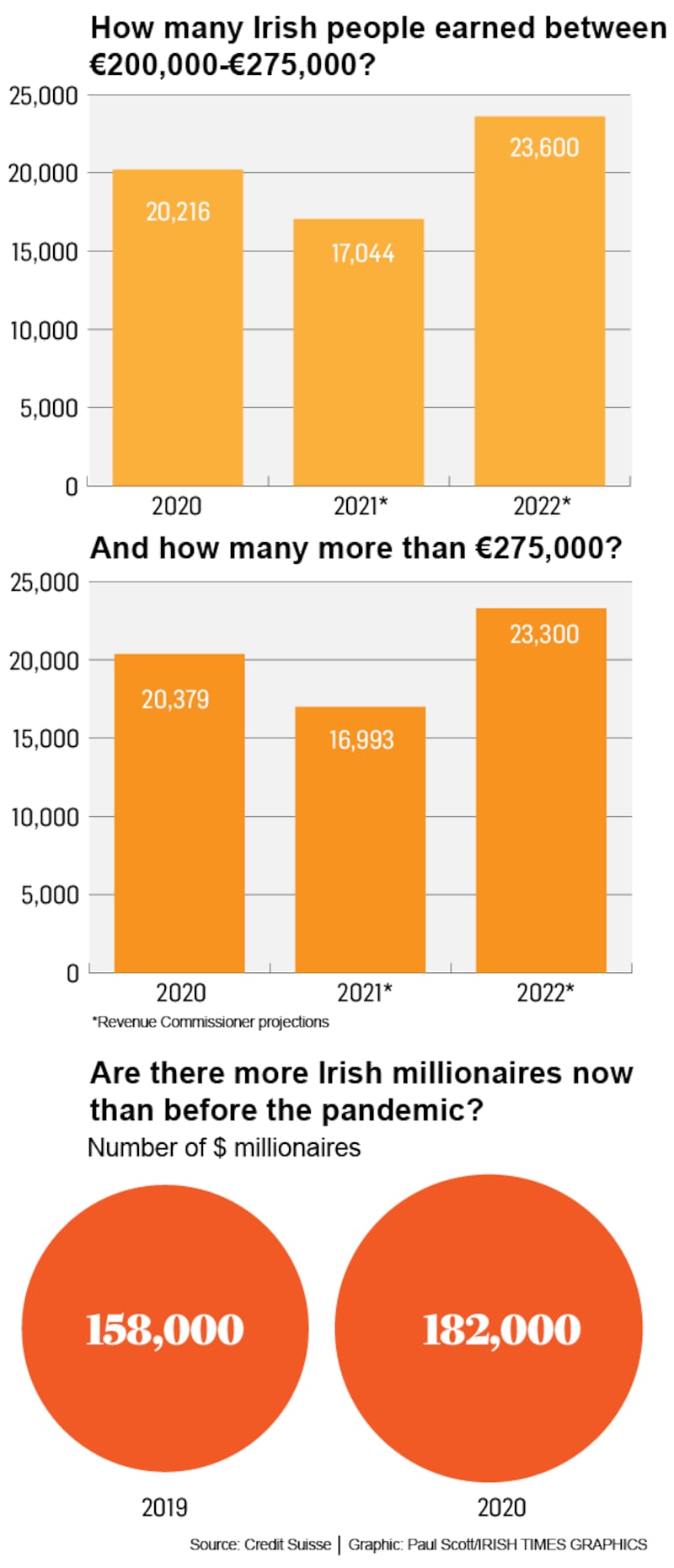The pandemic may have hit everyone in a myriad of ways but global figures show that it hit the less well off considerably more than it did the wealthy.
An Oxfam report earlier this year found the world's 10 richest men saw their wealth increase by half a trillion dollars during the pandemic, noting it could take up to a decade for the world's poorest to recover. A survey of economists worldwide, also from Oxfam, found that 87 per cent of people felt that pandemic would lead to an increase or a major increase in income inequality in their country.
But what is the situation in Ireland? Did the rich continue to get richer? And what about lower- and middle-income earners? Using figures from the Revenue Commissioners and Credit Suisse, we take a look at how the fortunes of different income earners fared over the past few years.

Trends in income
To start with, we can take a look at how many people actually earned an income during the past few years, using the Revenue’s ready reckoner. This shows tax projections for the coming year, which are a good approximation of overall trends.
It gives an indication of the number of people who were earning an income throughout the pandemic.
The downside of these figures is the fact that they are based on “tax units”. A couple who are jointly assessed is considered as one “unit”. While Revenue does publish similar figures on an individual basis, the most recent year available is 2018.
So what do the “tax unit” figures tell us?
Well, first of all, looking at pre-budget publications from August or September of 2019, 2020 and 2021, we see that the number of income earners in Ireland dipped during the pandemic.
In early autumn 2019, Revenue projected there would be 2.8 million units earning an income in 2020. Of these, 943,500, or 34 per cent, paid no income tax, while 28 per cent paid neither income tax nor the universal social charge (USC).
A year later, however, in autumn 2020 as the Covid-19 pandemic had started to bite hard, the Revenue’s projections for the following year had dipped. That year, it projected 2.6 million income earners for 2021, a decrease of about 6 per cent. And of those who would retain an income, the proportion outside the income tax net – presumably due to a low level of earnings – also rose, up to 962,100, representing 37 per cent of the total. The proportion paying neither income tax nor USC also rose, up to 30 per cent.
But what a difference a year can make. While the impact of Covid on the nation’s finances is clear from the above, by the late summer of 2021, Revenue was projecting a much brighter outlook.
It is now expecting the number of income earners to increase to 2.9 million for the year ahead. And of these, the proportion outside the income tax net will drop back to 33 per cent, while the percentage of those paying neither income tax nor USC will also fall, back to 28 per cent.
What happened lower earners?
We can also use the data to consider how people on certain incomes fared. First, let’s look at those on incomes of up to €30,000. Here, we can see that the number earning €10,000 or less actually increased during the pandemic, up 2 per cent to 460,930 people.
This could be a result of those people seeing their incomes fall as a result of the pandemic.
The numbers in this cohort are projected to rise again this year, up by a further 3.5 per cent to 476,900. Again, this could be due to incomes falling – or new income earners starting to earn for the first time.
Overall, more people fell into this category in 2021, with a 2 per cent increase in numbers earning between €0 and €30,000, up to 1.37 million on 2020, when it stood at 1.35 million.
And this number will remain higher for 2022 than it was in 2020, at some 1.36 million. Rather than this being a result of people’s incomes falling, it is more likely down to the increase in overall income earners for 2022.
What happened middle-income earners?
Middle-income earners were also affected by the pandemic. In 2020, almost 1.1 million tax units earned between €30,000 and €75,000. However, these numbers slipped back as the pandemic deepened throughout 2020 and into 2021, resulting in an 11 per cent decline to about 939,000 for 2021.
As elsewhere, however, the post-pandemic recovery is also lifting incomes here, with the numbers in this middle-income cohort set to rise in 2022 to 1.07 million, an increase of 3.4 per cent on 2020.
The figures show that the biggest drop-off was among income earners in the €50,000-€60,000 category, with 16 per cent fewer taxpayers in this income cohort in 2021. Those in the €60,000-€70,000 category also fell substantially, down by 12.5 per cent.
Again the numbers in these categories for the coming year are back above 2020 levels, up by 6 per cent for those earning between €50,000-€60,000, and by 13.4 per cent in the €60,000-€70,000 cohort.
And high earners?
There is no doubt that higher earners were hit by the pandemic – hard. In autumn 2019, the Revenue projected that there would be 20,216 taxpayers earning between €200,000 and €275,000 in 2020, and a further 20,379 earning in excess of €275,000. Combined, this cohort was expected to earn €15.7 billion, or, on average, €386,747 each.
A year later, however, Revenue was forecasting a clear hit going into 2021. The number earning between €200,000 and €275,000 was projected to fall by almost a sixth, or 15.7 per cent, back to 17,044, while the number earning above that was expected to drop by 16.6 per cent to 16, 933.
Income earned among this cohort also declined, back to €13.1 billion. But the average income of those who remained in the cohort was almost unchanged at €385,555 each.
As with elsewhere however, Revenue’s projections for the year ahead show a strong recovery in the numbers of people earning at this level. More people will earn in excess of €200,000, with 23,600 expected to earn between €200,000 and €275,000, and a further 23,300 earning in excess of €275,000. Combined, this is up by 16 per cent on 2020, and by 37 per cent on 2021.
The income earned by this cohort will also surpass previous years, at some €18 billion, marking a sharp rebound on the previous year. However, on an individual basis, the average income per head, or unit, will actually fall again – to €383,795.
What about millionaires?
Revenue’s data on incomes only goes so far; if we want to know how Ireland’s super-rich have fared, we need to turn to a wealth report compiled by the likes of Swiss bank Credit Suisse.
It’s not as easy to identify pandemic trends – or at least not yet – but the data in its latest report for 2021 does show a striking rise in wealth among Ireland’s high-net-worth individuals during the year the pandemic first hit, 2020.
In 2000, for example, dollar millionaires accounted for just 1.4 per cent of the Irish population. This picked up strongly in subsequent years, reaching 5.5 per cent in 2020. That is a higher proportion of the population that in the UK (4.7 per cent), Norway (4.2 per cent) and Russia (0.2 per cent), though it is lower than Switzerland (15 per cent), Australia (9.4 per cent) or the United States (8.8 per cent).
To look at a different way, 5.5 (okay, let’s say six!) out of every 100 people in Ireland is a millionaire. If this surprises, then it’s worth noting how Credit Suisse compiles its data. It includes, in an Irish context at least, those all-important property assets, including the family home, as well as pension funds.
Other wealth reports cover only “investable assets”, which would give lower numbers in the millionaire category.
It means then, that in terms of overall wealth, Ireland is right up there with the world's richest. With mean wealth of $266,150 per head (€229,434), up by $12,450 on 2019, the Irish are the 17th richest in the world, according to Credit Suisse's data, behind Switzerland ($673,960), the US (second on $505,420), Hong Kong (third on $503,340), New Zealand (eighth on $348,200) and the UK (13th on $290,750).
When median wealth is considered, Ireland is 15th, with median wealth of $99,030, up by $4,960 on the prior year.
And the data also shows that the number of Irish dollar millionaires continues to rise. Back in 2019, there were 158,000 adults with assets worth more than $1 million: a year later, this had jumped by 5 per cent to 182,000, as a further 24,000 adults made the grade – despite the impact of the pandemic.
Most of these millionaires are at the lower end of the wealth grade, with 166,374 adults having wealth of $5 million or less. Moreover, there has been some slippage among those approaching billionaire status. In 2019, there were 19 in the $500 million-plus category; in 2020, this fell back to just nine.





















